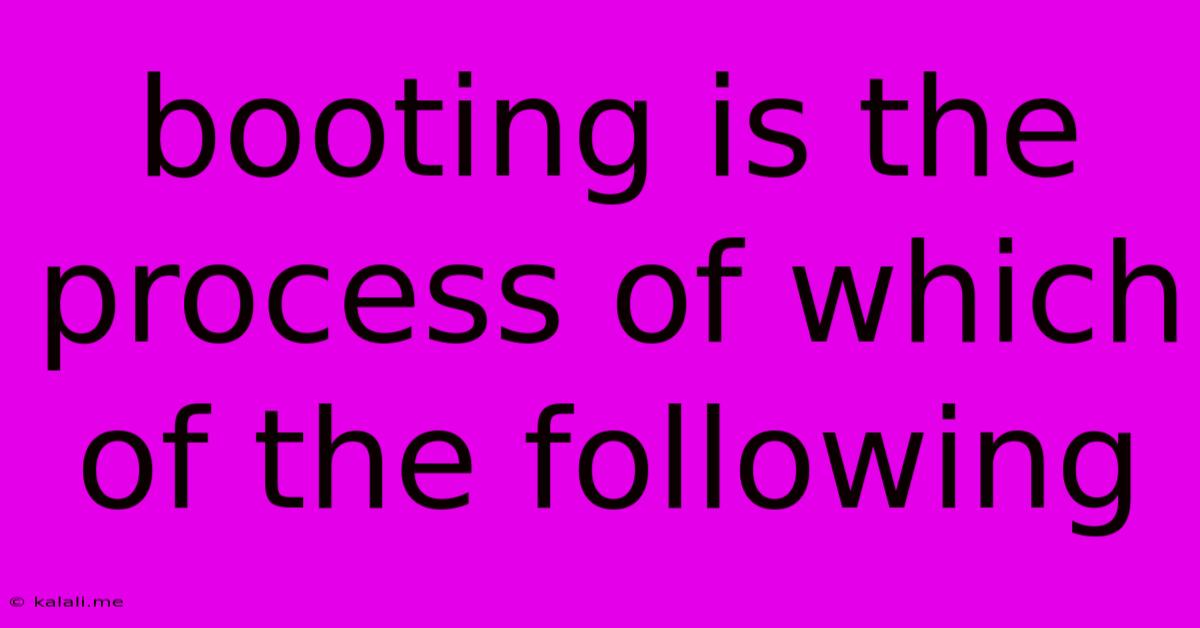Booting Is The Process Of Which Of The Following
Kalali
Jun 14, 2025 · 3 min read

Table of Contents
Booting: The Process of Starting Your Computer
Booting is the process of starting a computer and loading its operating system (OS). It's the sequence of events that takes your machine from a completely powered-off state to the point where you see your desktop and can start working. Understanding the booting process is crucial for troubleshooting computer issues and optimizing performance. This article will delve into the detailed steps involved in this essential procedure.
What Happens During Booting?
The boot process isn't a single action; it's a carefully orchestrated series of steps. These steps can vary slightly depending on the type of computer (desktop, laptop, server) and its BIOS/UEFI settings, but the general sequence remains consistent. Think of it as a relay race, where each component passes the baton to the next.
1. Power On Self-Test (POST): The Initial Check-up
When you press the power button, the Power On Self-Test (POST) begins. This is a crucial diagnostic phase where the computer's hardware is checked for functionality. This includes:
- Checking the CPU: Ensuring the central processing unit is working correctly.
- Memory Test (RAM): Verifying the random access memory is operational and accessible.
- Checking Storage Devices: Identifying and verifying hard drives, solid-state drives (SSDs), and other storage media.
- Peripheral Device Check: Assessing connected devices like keyboards, mice, and graphic cards.
If any errors are detected during POST, the system might beep, display error codes, or halt the boot process entirely. These error messages can help you diagnose hardware problems.
2. BIOS/UEFI Initialization: The Master Boot Record
After POST, the system loads the Basic Input/Output System (BIOS) or Unified Extensible Firmware Interface (UEFI). This firmware is crucial for initializing hardware and loading the boot loader. The BIOS/UEFI is responsible for:
- Locating Boot Devices: Identifying bootable drives, typically the hard drive or SSD containing the operating system.
- Loading the Boot Loader: The BIOS/UEFI loads the boot loader, a small program that initiates the OS loading process. This is often located in the Master Boot Record (MBR) or GUID Partition Table (GPT), depending on the disk partitioning scheme.
The selection of the boot device can usually be configured in the BIOS/UEFI settings. This is where you might choose to boot from a USB drive containing a recovery tool or an operating system installer.
3. Boot Loader Execution: Starting the Operating System
The boot loader, such as GRUB (GRand Unified Bootloader) or Windows Boot Manager, is now executed. This program's primary responsibility is to load the operating system kernel. The boot loader does the following:
- Loading the Kernel: Loads the core of the operating system into RAM.
- Loading Drivers: Loads essential device drivers needed for the OS to interact with hardware.
- Starting System Services: Initiates system processes and services that form the base for the operating system's functionality.
This stage is where you might see a splash screen or logo from your operating system manufacturer.
4. Operating System Initialization: The Final Steps
Once the kernel and essential drivers are loaded, the operating system takes over. The OS completes its initialization process:
- Loading User Interface: Loads the graphical user interface (GUI), which you interact with daily.
- Starting Applications: Launches any startup applications or services configured to load automatically.
And finally, you’ll see your desktop, ready to start your work.
Understanding the boot process, from POST to OS initialization, provides valuable insight into your computer's functionality. This knowledge is essential for effective troubleshooting and maintaining the optimal performance of your system.
Latest Posts
Latest Posts
-
Parts Of Four Stroke Petrol Engine
Jun 15, 2025
-
Which Of These Storage Devices Provides The Highest Capacity
Jun 15, 2025
-
The First Step In The Problem Solving Process Is To
Jun 15, 2025
-
Routers Operate At Which Osi Layer
Jun 15, 2025
-
Is Moment The Same As Torque
Jun 15, 2025
Related Post
Thank you for visiting our website which covers about Booting Is The Process Of Which Of The Following . We hope the information provided has been useful to you. Feel free to contact us if you have any questions or need further assistance. See you next time and don't miss to bookmark.